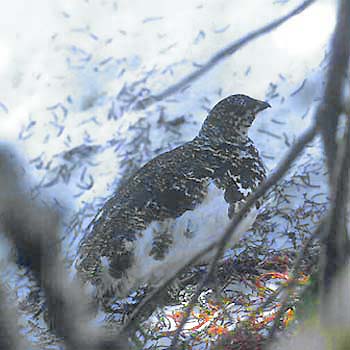
a web page by Don Roberson |
GROUSE Tetraoninae a subfamily of the Pheasants & allies Phasianidae |
||||
|
||||
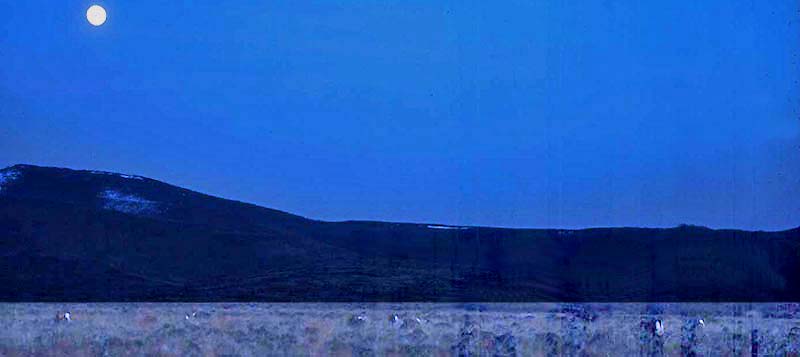 |
||||
The AOU recently split the sage grouse into two species: the more widespread Greater Sage-Grouse (shown here) and the very localized Gunnison Sage-Grouse C. minimus. This research happened so quickly and without foreshadowing that the slightly earlier HBW account (de Juana 1994) didn't even list the latter taxon as a subspecies! |
||||
The Grouse are a clade of gallinaceous birds of higher latitudes in North America and Eurasia. There is little doubt that the Tetraonidae form a fairly homogeneous group (de Juana 1994) but whether they should be considered a full family or simply a subfamily of the Phasianidae has been debated in the past. However, molecular evidence now shows that this lineage is embedded within the broader pheasant/partridge group, and they are just a subfamily (Dimcheff et al. 2002, AOU 1998). Grouse differ from the rest of pheasants in a number of ways: feathered nostrils; tarsi without spurs and usually with feathers instead of scales; feathered toes (in most species); and often the presence of a comb above the eye, usually in bright colors of bare skin (de Juana 1994). Most, if not all, of these seem to be adaptations to cold climates. These resident birds live through freezing cold winters, often amongst heavy snow. Grouse can be a serious challenge to see, and even more so to photograph. Although they dance at traditional sites, they are easily disturbed. For Sharp-tailed Grouse, for example, must enter a blind on the open prairie well before dawn (the blind above is at Crescent Lake NWR in Nebraska; it must be reserved well in advance), and then peer through a small opening (above right). Often there is snow on the ground. It can be bone-chilling cold in those cramped conditions, but one must stay until well after the sun is up and the grouse have departed. |
||||
|
||||
Among these the prairie grouse have the most elaborate leks and displays, and are the most endangered. Agriculture has taken most of the American prairies, leaving only isolated populations scattered about the Great Plains or the Great Basin. Populations of Lesser Prairie-Chicken (right) are particularly fragmented. W. Ed Harper took this fine shot at Arnett, Oklahoma. Note particularly the rabbit-like appearance of two nape feathers when fully erected. Two coastal populations of Greater Prairie-Chicken T. cupido are now either extinct or highly endangered. The 'Heath Hen' (nominate cupido) of northeastern U.S. went extinct on Martha's Vineyard I., Massachusetts, in 1932. 'Atwater's Prairie-Chicken' T. c. attwateri is severely endangered in coastal Texas; that population is now in the few hundreds and declining. At least you can usually drive somewhere near a lek of the various prairie and sage grouse in early spring; locating one of the forest grouse can be more of a challenge. In prime habitat it may not be hard to hear — or, actually, to feel — the fast vibrating wing-beats of a male Ruffed Grouse Bonasa umbellus; but just try to sneak up to him on his display log. Usually very alert, he slips off the log and into the woods just about the time you finally catch your first glimpse. |
||||
In Eurasia, one has similar challenges with Western Capercaillie Tetrao urogallus, not to mention such little-known and elusive species as Caucasian Black Grouse T. mlokosiewiczi or Severtsov's Grouse B. sewerzowi of central China. |
||||
|
||||
The ptarmigan and some other widespread grouse have been subdivided into numerous subspecies. To some extent this makes sense because they are resident birds that have been subject to local environmental pressures for eons, and local variation would be expected. Yet many of the described differences are clinal and numerous named subspecies may not be diagnosable. Some subspecies are distinctive, but we might expect future revisions amongst the 30 races of Rock Ptarmigan, 16 races of Willow Ptarmigan, 12 subspecies of Hazel Grouse B. bonasia, or 14 races of Ruffed Grouse (per de Juana 1994). Incidentally, the Rock Ptarmigan shown after is currently considered to represent the race evermanni, entirely restricted to Attu Island. Study sometimes suggests that named subspecies are actually separate species; indeed, the "Blue Grouse" of western North America was recently split into Sooty Grouse Dendragapus fuliginosus and Dusky Grouse D. obscurus. Given their retiring habits and cryptic plumages, it is always a treat to come upon any of the grouse during a morning's birding. Photography is even more fun. I recall a slide show given by Kenneth Fink at a Western Field Ornithologist's convention in Santa Barbara way back in 1978. He had stalked and upon incredible photos of all the America grouse. I remember thinking then that it was the best slide show I'd ever seen, and among the greatest feats for any photographer. |
||||
Photos: The Greater Sage-Grouse Centrocercus urophasianus lek shown with the moon at predawn, and the displaying male, is near Honey Lake, Lassen Co., California; these photos were taken 5 Apr 1996. The lekking Sharp-tailed Grouse Tympanuchus phasianellus was at a traditional site at Crescent Lake NWR, Nebraska, on 14 Apr 1995; the blind shown is the one used for the photos; Rita Carratello took the photo of Don. The displaying male Lesser Prairie-Chicken T. pallidicinctus was at a lek at Arnett, Oklahoma, on 4 Apr 1985; the photo was taken by W. Ed Harper. The female Sooty Grouse Dendragapus fuliginosus was at Summit Lake, Yosemite Nat'l Park, California, in Sep 1981. The male Rock Ptarmigan Lagopus mutus was on Attu I., Alaska, on 18 May 1980. The White-tailed Ptarmigan L. leucurus was high up Mt. Rainier, Washington, on 4 July 1974 (and is one of my early bird photos before I had a telephoto lens). The male Willow Ptarmigan L. lagopus was calling at Churchill, Manitoba, Canada, in July 1988. All photos © Don Roberson, except the prairie-chicken © W. Ed Harper and used with permission; all rights reserved. Bibliographic note: There are numerous coffee-table "survey" books that include grouse among "game birds." I understand that there is also a new family book in the Princeton series (Madge & McGowan 2002) that covers this family. I've not seen that effort but reviews have been mixed, suggesting it has a strong European bias and has missed much of the recent American literature (e.g., see Auk 120: 920-921). I'm not a big fan of various "group books" written by Paul Johnsgard, but I did find his Grouse and Quails of North America (Johnsgard 1973) to be an exception. It is nicely written and well-illustrated (photos — although too many in black-and-white — and some full-page art rather than field guide vignettes). Obviously, it is restricted to American species. By now it, too, is quite dated. A more recent introduction to the family, with a some very fine photos, is de Juana (1994). Literature cited:
|
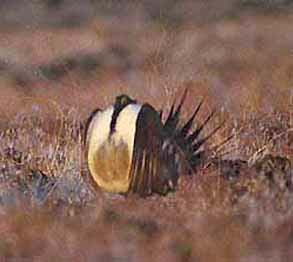 One
shivers in the predawn cold on the open sage in early spring, but one
must be very still. They're out there and they cannot be disturbed.
Beginning the ancient rituals of the lek, the Greater Sage-Grouse
(lek above and displaying male right) males announce their availability
on the Great Basin sage through impressive air sacs: blop-blop! they
go, like uncorking two huge magnums of wine. These shots were taken
from a half-blind composed of rocks in an old lava flow, and one is
exposed to the elements above and behind in those circumstances. One
must lay stock-still to avoid disturbing the displaying grouse in the
icy pre-dawn chill.
One
shivers in the predawn cold on the open sage in early spring, but one
must be very still. They're out there and they cannot be disturbed.
Beginning the ancient rituals of the lek, the Greater Sage-Grouse
(lek above and displaying male right) males announce their availability
on the Great Basin sage through impressive air sacs: blop-blop! they
go, like uncorking two huge magnums of wine. These shots were taken
from a half-blind composed of rocks in an old lava flow, and one is
exposed to the elements above and behind in those circumstances. One
must lay stock-still to avoid disturbing the displaying grouse in the
icy pre-dawn chill. 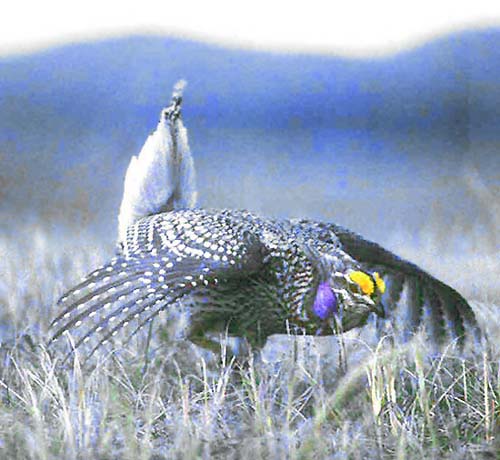 Several hundred miles east, the Sharp-tailed Grouse (left) engages in a vigorous foot-stomp and tail-rattling, the feet and tail tip moving so fast as to be a blur.
Several hundred miles east, the Sharp-tailed Grouse (left) engages in a vigorous foot-stomp and tail-rattling, the feet and tail tip moving so fast as to be a blur.
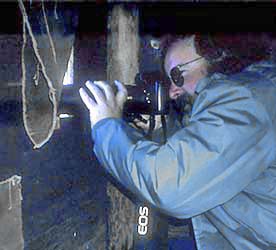
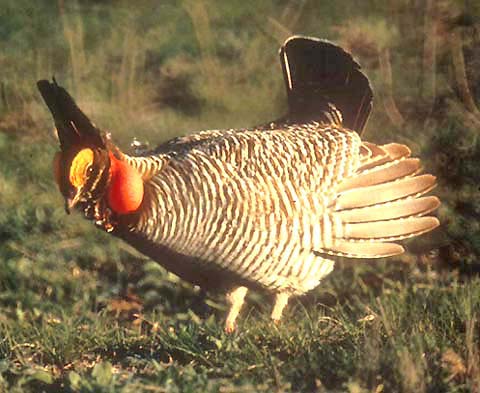 One can think of the grouse as three sets: the prairie and sage grouse (5 species in the genera Centrocercus and Tympanuchus), the forest grouse (10 species in 2-3 genera), and the alpine/arctic ptarmigan (3 species in Lagopus, and maybe one more if British race of Willow Ptarmigan, L. l. scoticus ["Red Grouse"] is considered a good species).
One can think of the grouse as three sets: the prairie and sage grouse (5 species in the genera Centrocercus and Tympanuchus), the forest grouse (10 species in 2-3 genera), and the alpine/arctic ptarmigan (3 species in Lagopus, and maybe one more if British race of Willow Ptarmigan, L. l. scoticus ["Red Grouse"] is considered a good species).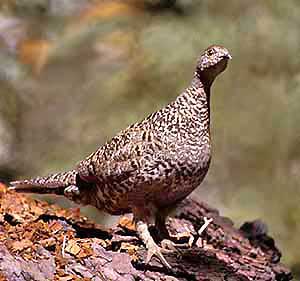 Booming
Sooty Grouse are likewise widespread in spring and early summer up in
the Sierra Nevada, but trying to spot the statuesque male high in a
tall fir can be very difficult. Rita and I spent over an hour on one
last spring in Kings Canyon Nat'l Park, California. It didn't take long
to figure out exactly which tree it must be in, but we just couldn't
spot him. Eventually, by splitting up and looking at both sides at
once, we figured out that he was watching us and moved just enough
around the thick branches in the crown to keep the main trunk between
him and us, all the while booming every minute or so! It can be easier
to find females with young later in the summer, but this takes some
luck. This female Sooty Grouse (left) was accompanying a brood of youngsters. It is remarkable how well all were camouflaged.
Booming
Sooty Grouse are likewise widespread in spring and early summer up in
the Sierra Nevada, but trying to spot the statuesque male high in a
tall fir can be very difficult. Rita and I spent over an hour on one
last spring in Kings Canyon Nat'l Park, California. It didn't take long
to figure out exactly which tree it must be in, but we just couldn't
spot him. Eventually, by splitting up and looking at both sides at
once, we figured out that he was watching us and moved just enough
around the thick branches in the crown to keep the main trunk between
him and us, all the while booming every minute or so! It can be easier
to find females with young later in the summer, but this takes some
luck. This female Sooty Grouse (left) was accompanying a brood of youngsters. It is remarkable how well all were camouflaged.
